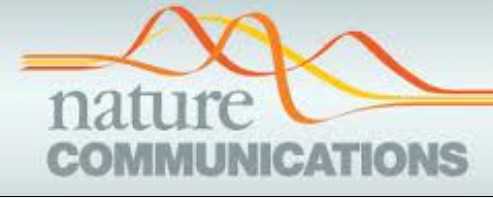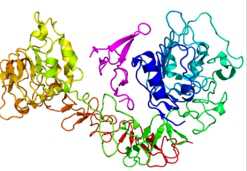Cell Res:季红斌等发现新的肺癌致病融合基因CCDC6-RET
2012-02-24 MedSci MedSci原创
近日,国际著名杂志Cell research在线刊登了中科院上海生科院生化与细胞所季红斌研究组与复旦大学肿瘤医院合作的最新研究成果”Identification of RET gene fusion by exon array analyses in "pan-negative" lung adenocarcinomas from never smokers,”。文章中,研究者通过对Affymet
近日,国际著名杂志Cell research在线刊登了中科院上海生科院生化与细胞所季红斌研究组与复旦大学肿瘤医院合作的最新研究成果”Identification of RET gene fusion by exon array analyses in "pan-negative" lung adenocarcinomas from never smokers,”。文章中,研究者通过对Affymetrix外显子芯片的分析及实验验证,在非吸烟肺腺癌患者中寻找到一个新的致病基因融合CCDC6-RET。
肺癌是严重危害我国人民生命健康的重大疾病之一,揭示其中关键的致病基因将为临床上肺癌的“个体化”分子靶向治疗提供潜在的药靶和新的策略。季红斌课题组长期从事肺癌基因组学的研究,以寻找关键的肺癌致病基因。该课题组前期的工作为非吸烟肺腺癌患者绘制了较为完备的致病基因图谱,揭示了绝大多数肺腺癌中存在的关键致病基因,而只有少数肺腺癌(24/202)中的关键致病基因还不得而知。
目前,该研究组利用Affymetrix的外显子芯片,对这些可能具有未知致病基因的肺腺癌样本进行了深入分析。生物信息学以及实验验证结果表明,在大约10% (2/24)的肿瘤样本中存在着一个新的肺癌致病基因融合CCDC6-RET。进一步的研究确证了该基因融合来源于染色体DNA水平的转位。
以往的研究表明该RET基因融合常见于甲状腺癌样本中,它的过表达会导致肿瘤的发生;但关于该基因融合在其它类型的肿瘤中还未见报道。RET是一个受体酪氨酸激酶,在正常的肺组织中表达较低;而该基因突变融合了CCDC6的胞外域以及RET的激酶活性区,在肺癌样本中往往表达较高,而这可能是导致肺癌发病的关键所在。
最近在线发表的三篇Nat Med 文章和一篇Genome Res文章也报道了类似的工作,指出RET融合基因是肺癌中新的关键致病基因。目前临床上已经有能够有效抑制RET激酶活性的抑制剂,因此这些研究对于那些具有RET基因融合的肺腺癌患者的“个体化”治疗,将具有直接的指导意义。
该研究课题获得科技部、国家自然科学基金委和上海市科委的经费支持。

doi:10.1038/cr.2012.27
PMC:
PMID:
Identification of RET gene fusion by exon array analyses in "pan-negative" lung adenocarcinomas from never smokers.
Fei Li1,*, Yan Feng1,*, Rong Fang1,*, Zhaoyuan Fang1, Jufeng Xia1, Xiangkun Han1, Xin-Yuan Liu1, Haiquan Chen2,3, Hongyan Liu1 and Hongbin Ji1
The incidence of lung cancer from never smokers has increased dramatically in China nowadays. Strikingly, approximately 30% of the lung cancer patients in East Asian population are never smokers1, 2. The majority of these patients are females with lung adenocarcinomas2. Identification of oncogenic drivers, which the tumors are “addicted to" and rely on for survival, has significantly reformed the current strategies for lung cancer treatment in clinic and initiated the era of personalized therapy3. Therapeutics specifically targeting EGFR mutations, frequently observed in never smoker patients with lung cancer, have been very helpful in improving the clinical symptoms as well as the progression-free survival4, 5, 6. Similarly, patients with lung tumors positive for ALK fusions also benefit from ALK-targeted therapy7, 8. Our previous efforts have constructed a quite comprehensive map of those essential oncogenic drivers in 52 lung adenocarcinomas from never smokers9. We have uncovered the oncognic drivers in about 90% of these lung tumors including mutations of EGFR, HER2, KRAS, as well as EML4-ALK fusion9, thus providing a strong clinical guidance for molecular-targeted therapy for this subset of disease. However, there is still about 10% (5/52) of these never smoker patients were “pan-negative” for all known oncogenic driver mutations and could not benefit from the effective targeted therapy in clinic.
本网站所有内容来源注明为“梅斯医学”或“MedSci原创”的文字、图片和音视频资料,版权均属于梅斯医学所有。非经授权,任何媒体、网站或个人不得转载,授权转载时须注明来源为“梅斯医学”。其它来源的文章系转载文章,或“梅斯号”自媒体发布的文章,仅系出于传递更多信息之目的,本站仅负责审核内容合规,其内容不代表本站立场,本站不负责内容的准确性和版权。如果存在侵权、或不希望被转载的媒体或个人可与我们联系,我们将立即进行删除处理。
在此留言











#RET#
70
#Cell#
67
#CEL#
72
#融合#
82
#融合基因#
68